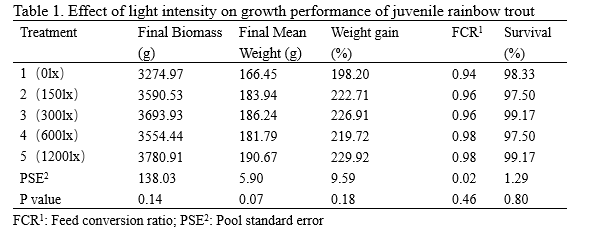EFFECT OF LIGHT INTENSITY ON GROWTH AND HIGH-TEMPERATURE TOLERANCE OF JUVENILE RAINBOW TROUT Oncorhynchus mykiss
In order to meet the demand of salmon market, Chinese scientists and entrepreneur are working on salmon mariculture far offshore in the Yellow Sea, China. Light is one of the most dominant environmental regulating the growth of salmonids. Optimal Light regulation technology is vital for far offshore salmon mariculture, especially in a full-submersible cage in China. The objective of this study is to evaluate the growth and high-temperature tolerance of juvenile rainbow trout (Oncorhynchus mykiss) in response to different light intensities. Five treatments were designed with different light intensities (0lx, 150lx, 300lx, 600lx and 1200lx) using LED lights as illuminant. The photoperiod was 12L:12D.
Juvenile rainbow trout (N=6; initial weight 56.90±1.01g) were fed the diets for eight weeks and subsequently underwent the high-temperature acclimation. This experiment has five treatments at a stocking density of 20 fish per tank. At the end of the 8-week period, all fish were weighted. After that, the temperature (initial 16.5 ?) was increased to 24 ? for 72 with a rate less than 1 ? per hour. Subsequently, the temperature decreased to 16.5? for 2 weeks. On days 1, 7 and 14 after high temperature acclimation as well as at the end of the growth trial, growth hormone (GH), Insulin-like growth factor (IGF-?), melatonin (MT), stomach digestive enzymes activity, intestinal digestive enzyme activity, cortisol, superoxide dismutase (SOD) activity, catalase (CAT) activity, glutathione peroxidase (GPX) activity, lipid peroxides (LPO) and malondialdehyde (MDA), immunoglobulin M and heat shock protein 70 (HSP70) will be determined. At the end of the growth trial, there were no significant differences in final mean weight (166.45-190.67g), final biomass (3274.97-3780.91g), survival (97.50-99.17%), percent weight gain (198.20-229.92%) or FCR (0.94-0.98) (Table 1). The molecular mechanism of optimal light density on growth rainbow trout needs to be further studied.
